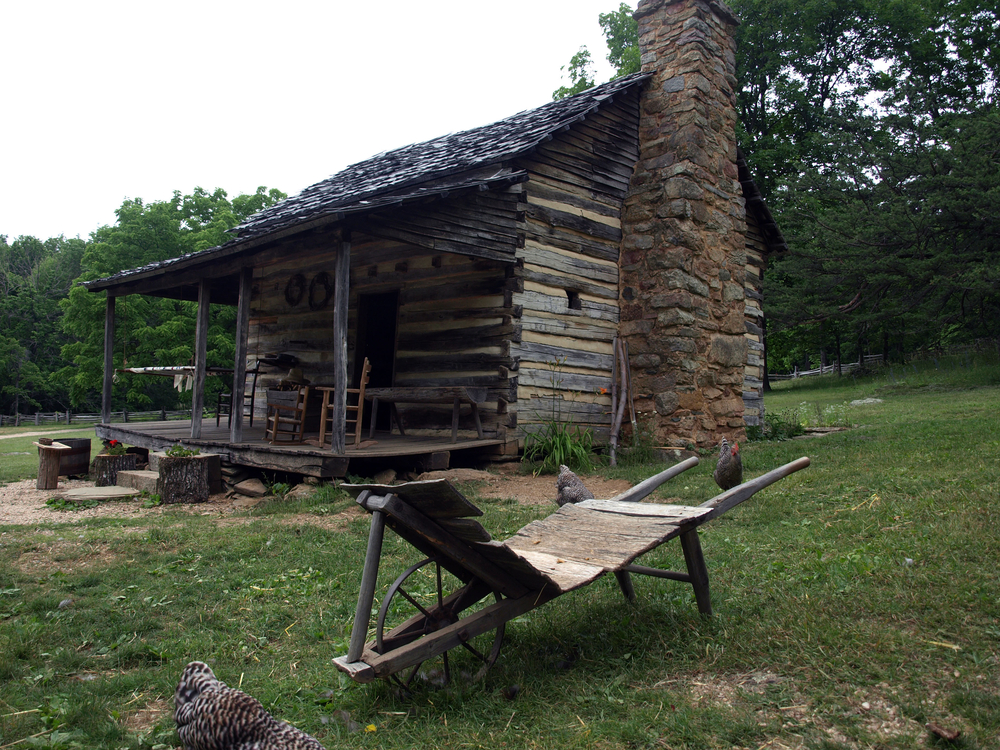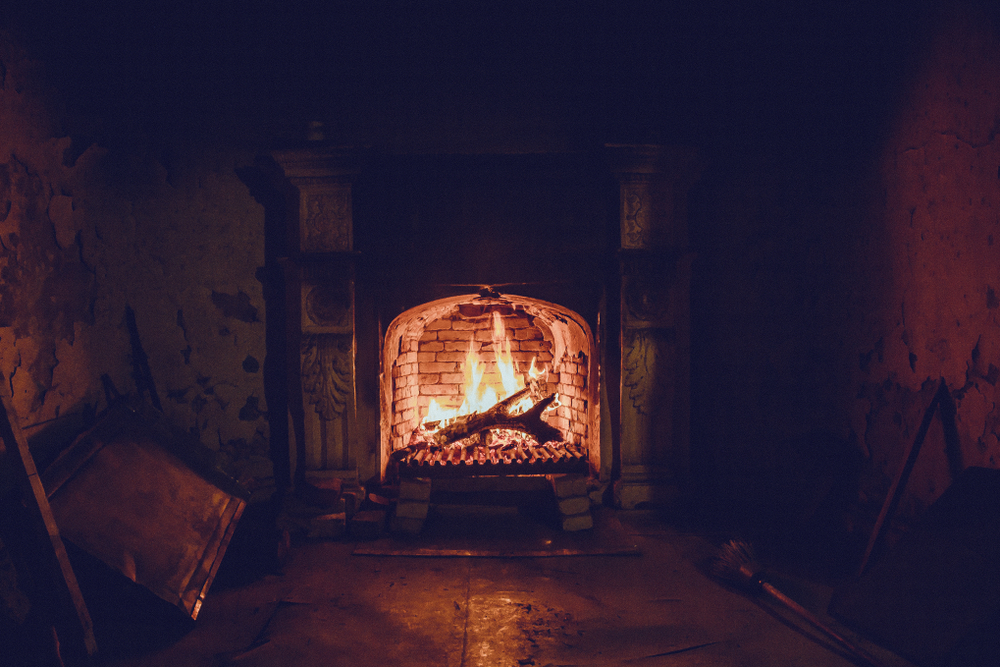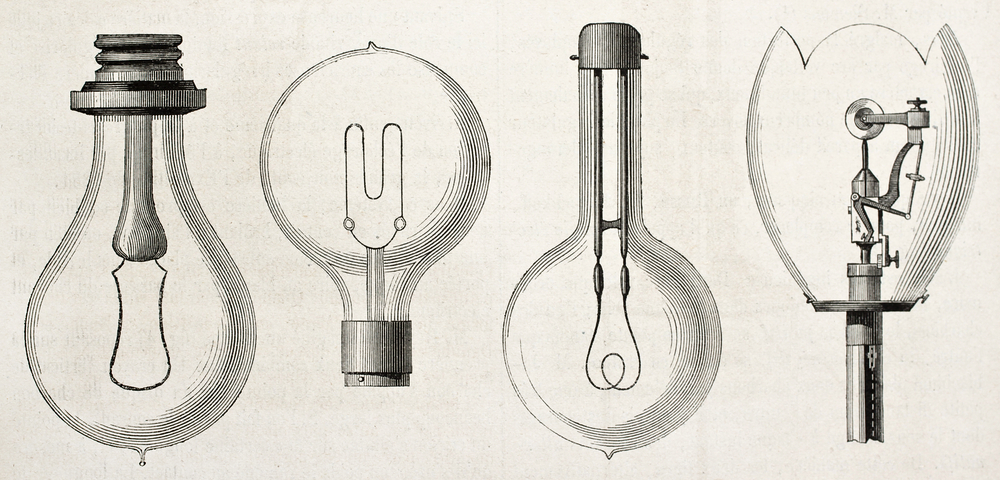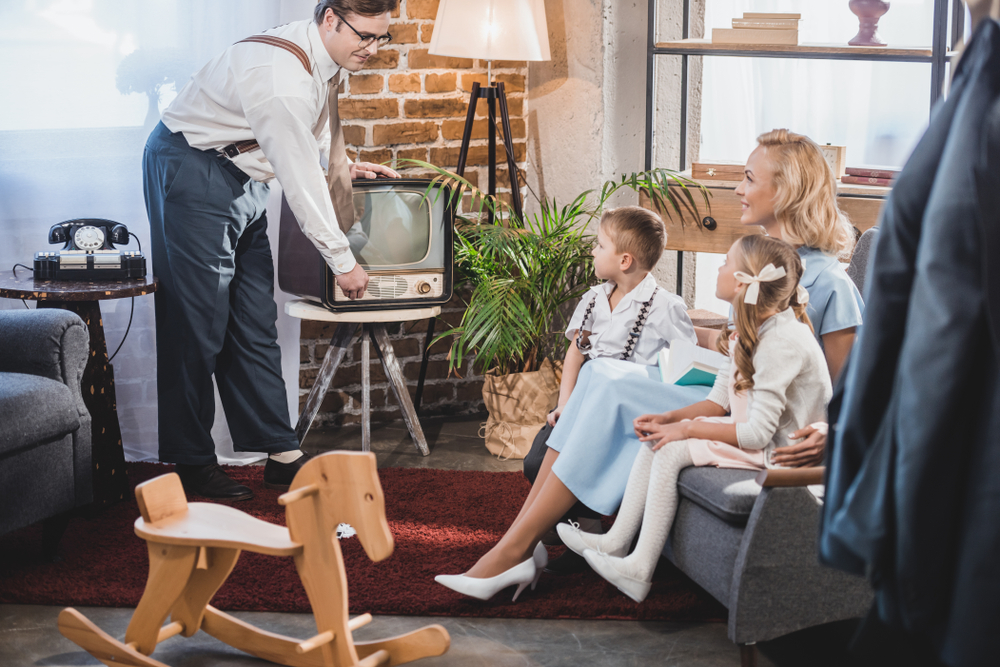Imagine waking up to the light of the sun in 1850. It’s summertime, around 6 am. You go downstairs, stoke the fire and get breakfast together as your children start to wake. Outside thunderhead clouds are heading towards you, darkening the land. Lighting a few lamps, you prepare for a quiet afternoon inside, knitting and sewing with your daughters while the boys wrestle in the flickering light. It rains all day. You’re running low on kerosene oil, so off to an early bedtime. Maybe tomorrow will be brighter, less restricted.

In a world of modern conveniences, it’s easy to take something like our control of light for granted. Did you know that lightbulbs have been around for less than 150 years? Revisiting the history of home lighting may inspire you to see your home with new eyes.
Before the Light Bulb
For thousands of years, humankind has lived according to the cycle of the sun and moon. The earliest humans relied on fire and learned to control it over time. Wax and oil made fire portable and practical through the use of torches, candles, and lamps.

This “domestication” of fire spurred innovation. There were more hours to use in the long dark winters, which gave humans time to craft and study. Still, firelight wasn’t nearly as bright or even as the sun. It produced a lot of heat, required care to keep alive, and created black smoke and soot.
Fire was far from a perfect lighting solution. Inventors around the world continued to pursue a better solution without much success. It wasn’t until the 19th century that inventors saw progress with electricity and light.
The Invention of the Light Bulb
The first successful version of electric light was achieved in 1835. This bulb, called the arc lamp, was invented in London and was popular in street lighting. Although it was a huge step forward in the development of electric light, there were still plenty of technical problems to solve. The arc lamp was extremely bright and hot, so it had to be on high towers for safety. The glaring light made it impossible to use in the small rooms of private homes. Even in the 1800s, critics were wary of the invasion of technology into private life. More work needed to be done.

More than forty years later, Thomas Edison successfully created a light bulb that wasn’t excessively hot or bright. He invented the first incandescent bulb in 1879 in New Jersey. These bulbs used electricity and gas to sustain the slow burn of filament. The light was powerful enough to light a room.
The incandescent bulb changed the world. The ability to have consistent, clean light on demand meant that hospitals, schools, governments, businesses, and the public could control their work. Its use was able to increase health, safety, and productivity.
It wasn’t until the mid-20th century that incandescent bulbs were commonly used in middle-class homes, decades after the death of the brilliant inventor Edison. The evolution of electric light was far from over. As incandescent light bulbs became commonplace, energy consumption greatly increased and we began to record harmful effects to the climate. Once again, we needed a new light solution.
Evolution of EcoFriendly Bulbs
Now imagine it’s 1950. You’ve moved into a new home in “Leave it to Beaver” suburbia. White picket fences, green lawns, neat houses, all wired to the now publicly available electricity network. You pause and think back on your childhood, the challenges of life before this technology. You smile. This is a new world for your children. You flip the switch on in the family room to spend some quality time together.

As the general population adopted the use of electric light, energy consumption skyrocketed. This increase in demand for energy production started to impact the environment, as the most common energy production was the burning of coal and natural gas. The effects of global warming came to a head and we looked for ways to reduce our impact on the world. Although the groundwork for fluorescent and LED bulbs was laid long before our awareness of global warming, they turned out to be the key to energy-efficient lighting.
Fluorescent Bulbs
Several inventors got to work on fluorescent lighting, the process of passing electricity through the gas to create light. Even Thomas Eddison had a version of fluorescent light, although his was never mass-produced. George Inmann of General Electric finally secured a patent for a commercial version of the fluorescent light. This light was first sold in 1938, around the same time the incandescent light became a common household appliance.
Fluorescent light bulbs were first designed as long tubes, typically used in offices. A modified design adapted them for home use: a slim spiral tube the size of an incandescent bulb. These bulbs grew popular in the early 2000s. Fluorescent bulbs are much more energy-efficient than incandescent bulbs. Yet, many were wary of their use in homes because they contain mercury. Many families wanted to avoid the risk of broken bulbs.
LED Bulbs
The technology behind LEDs (light-emitting diodes) began back in 1907, when a British man named Henry Joseph Round experimented with a cat’s whisker and silicon carbide, somehow generating light. Several other inventors tried to harness LEDs, first succeeding in creating invisible infrared LEDs, then finally achieving visible red light in 1962.
LEDs have evolved to emit every color, are highly adaptable, and maintain popularity today. LEDs use a microchip to produce light instead of burning filament or gas, and are popular in both bulbs and strip lighting. The microchip design means LEDs are colorful, adding “fun” and “versatility” to “eco-friendly”. And, no mercury!
Light in Creating a Home
Back to today. Your home is custom lit in every space. It’s a beautiful summer night. The kids are in bed, the soft, warm glow of fairy lights giving them comfort. You lock the front door and see your walkway lit by solar-powered footlights. You turn off the lights in the kitchen, except for the cabinet lighting, which offers a gentle glow into the living room. You snuggle up with your partner to catch up on your favorite show.

We live in an era of ultimate convenience. Gone are the days when the weather or seasons dictate what we do. Modern technology has allowed us to use light to optimize health, safety, and design.
Despite all of the incredible things the light bulb has done for us, we will never fully be able to remove ourselves from the influence of the cycles of the sun and the moon. Much like our ancestors who lived life by the firelight, our bodies still rely on the cues of daylight and dusk to regulate our hormones and sleep cycle.
Modern innovators have developed a spectrum of bulb “temperatures”. The temperature, or wavelength, of light mimics either sunlight or firelight. Bright, cool light acts like the sun and is excellent for workspaces, like kitchens and home offices. Softer warm light sources are closer to firelight, and help our bodies to relax and prepare for sleep. It’s excellent for bedrooms, reading lamps, and by bathtubs.
The right light sources also help to protect our family and home from accidents and theft. Strip lighting along stairs is great for preventing falls. Motion-activated lights outside have protected families for decades by preventing nighttime theft.
Beyond function, light design controls the feel of your home. Two hundred years ago, pioneers and frontier families had the same, functional log cabin. Today light gives us all the opportunity to customize our homes to our family needs and interests. Simply upgrading the existing, builder-grade lights makes your home feel like it’s yours. Strip LEDs under your kitchen cabinets increase visibility, make it feel bigger, and upgrade it to a first-class workspace. Installing pendant lighting in the bedroom increases style and decreases chord clutter. A unique chandelier brightens your home office and helps you relax in a space that’s really you.
It’s incredible how much light has changed the world.
——————–
Talk with the Pros
With all the technology and styles available to you, it can be hard to know how best to take advantage of this era of light. Western Chandelier offers a great selection of not just bulbs and fixtures, but also professional lighting advice from experts in the lighting industry. If you’re ready to start lighting your home, stop by our showroom and we’ll help you find exactly what you need.
Leave a Reply